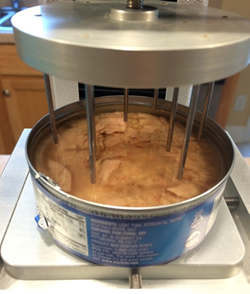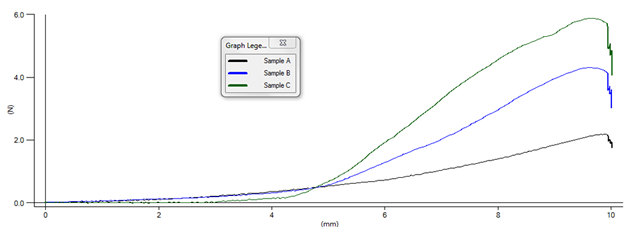Canned Tuna Firmness
Highlights
- Objective measurement of physical mouthfeel properties sensed in biting a fish product in its packaging
- Repeatable test method on a relatively non-homogeneous food item using a software-controlled texture analyzer
- Specialist multi-needle probe to penetrate the irregularly-spaced muscle and flesh components averaged throughout the serving
- Quantified hardness texture correlated to the firmness and tenderness of meat in processed and preserved form
Situation
 Is this can of tuna of the right texture? Which part of it? Testing for firmness has frequently meant expert but subjective judgment. How can these assessments be correlated with objective measurements for reliable and repeatable testing?
Is this can of tuna of the right texture? Which part of it? Testing for firmness has frequently meant expert but subjective judgment. How can these assessments be correlated with objective measurements for reliable and repeatable testing?
This example shows the method and results from mechanical testing of three cans of tuna in water.
Method
The testing was done using a Food Technology Corporation (FTC) TMS-Pro Texture Analyzer, fitted with a 25 N intelligent loadcell. A nine-point probe was used, to achieve penetration force readings averaged across the whole can. Testing the product in the can ensured that integrity of the sample was maintained.
For each test, the program advanced the probe to touch the sample, and then drove it down into the sample by 10 mm, before returning to the starting position. The sample was then rotated a few degrees for a further test to be averaged in, or for the next sample to be introduced.
The TL Pro Software calculated the peak force (firmness) and work done (energy) during the penetration cycle.
Results
The graphical representation from TL-Pro, of the test results for the four samples, is shown here (force applied, against cumulative displacement). The test results for the first test on each of the three samples are shown.

Experience will tell where the limits of acceptable firmness lie. The graph reveals more than just a peak force, which can add useful information. These three samples are distributed and the profile of sample A stands out as being noticeably flatter. Consistency in other factors are important here too, including nature and proportion of liquid, temperature, maintaining clean probes, and compression in the canning process.
The same results with additional calculations are shown here, which is more revealing in terms of the coefficient of variation, reflecting the fact that canned tuna is not a homogenous product, and that in this orientation some probes will always encounter interstices.

- Average = arithmetic mean
- SD = standard deviation
- CV = coefficient of variation: (SD/Mean) x 100
Significance
In principle, mechanical testing of the firmness of canned tuna is measurable with sufficient averaging around each sample. Other tests could be compared, for example a determined sample weight in a standard receptacle, with a given orientation of the flesh and a defined compression surface area. With the right controls, subjective acceptable texture can be defined in terms of objective mechanical measurement, and this data used to create a quick, reliable and repeatable production line test.
